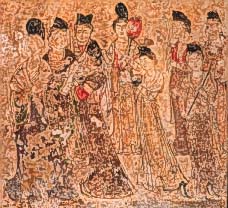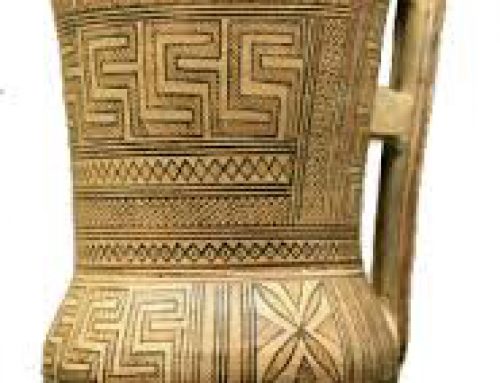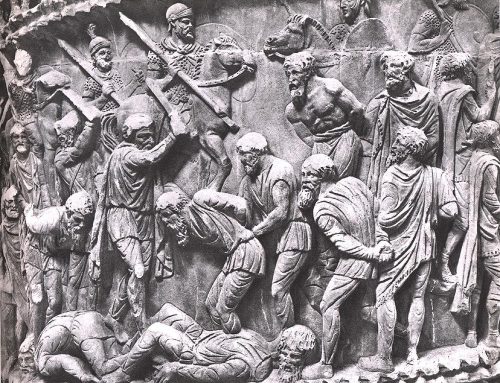
T’ang dynasty dancing women – Musee Guimet, Paris
Sculpture, which had really begun to develop during the Sui Dynasty, reached its height under the T’ang Dynasty. Sculptors emphasized graceful lines and sharp, clear forms, and good proportions (the head the right size for the body, the legs and arms the right length).

Musee Guimet, Paris

Wall-painting from the tomb of Princess Yongtai, showing palace servants, ca. 706 AD
But Chinese painters kept right up with the sculptors. Instead of painting mainly pictures of the Buddha, now artists painted scenes from history (famous emperors and famous battles), and scenes of everyday life at the emperor‘s court. They tried to make people look real and solid.

T’ang Emperor Taizong, in a later copy of a T’ang painting by Yen Li-pen (Beijing Palace Museum)

Landscape mural from the Dunhuang Caves
Nature was a more and more important theme to these painters. In the 700s AD, the painter Han Kan was famous for his paintings of horses, for instance, and many other artists also chose to paint animals.

Five Oxen, said to be by the T’ang artist Han Huang (Beijing Palace Museum)
Many famous artists lived during the T’ang Dynasty – Yen Li-pen, Wu Tao-tzu, Wang Wei, and Tung Yuan for instance – but none of their paintings survived. We do have some later copies of their paintings (see the one by Yen Li-pen on this page?).
Here’s a video of women dancing in Tang Dynasty style (compare their long sleeves with the figurines above).
Learn by doing: paint your own landscape
Tang Dynasty pottery (the first porcelain)
Bibliography and further reading about Tang Dynasty art:
The British Museum Book of Chinese Art, by Jessica Rawson and others (1996). Rawson is a curator at the British Museum, and she uses the collection of the British Museum to illustrate this book. Library Journal calls it “easily the best introductory overview of Chinese art to appear in years”.
Art in China (Oxford History of Art Series), by Craig Clunas (1997). Not specifically , but a good introduction to the spirit of Chinese art. Warning: this one is not arranged in chronological order. Instead, it has chapters on sculpture, calligraphy, and so on.
Arts of the Tang Court, by Patricia Eichenbaum Karetzky (1996). A brief introduction.




